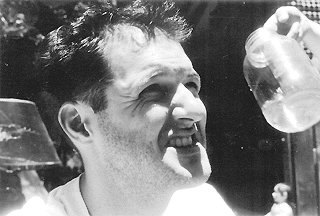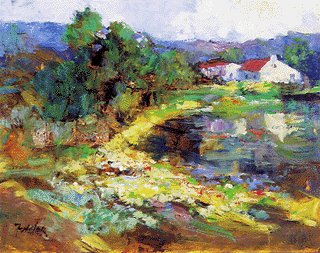Exhibitionism
Race of the Ark Tattoo: Trap Doors in the Mind
Fri., Aug. 14, 1998
through August 29
Running Time: 1 hr, 30 min

Other people's junk. That's what a flea market is, really. The stuff you hang onto in your own house for some pathological reason — the grimy Mason jars and dusty frames — except that it belongs to someone else. Just meaningless stuff, right? Except folded into each of those trinkets is a flash of history, a snapshot of memory. Some old, dirty sock, a childhood toy, even a stale, brittle postcard that's been collecting dust for years — they open a trap door in our mind, the way smelling the cologne of a long-lost love ushers that person instantly into your thoughts.
But in Race of the Ark Tattoo, Foster (Jason Phelps) has no memory. He explains early on that this is due to a childhood illness (mental, presumably), and a certain medication that causes blackouts. To compensate, he hoards junk in a flea market, a business previously run by his foster father, Homer. Frontera@Hyde Park Theatre has actually turned its space into a flea market — on the back porch, used books, old costumes, tapes, and broken telephones are really for sale. Inside the theatre, tables of junk are scattered about, carefully overseen by the lanky, boyish Foster. Because to him, this is an intensely private affair; this junk is all the memory he has. Throughout the play, he combs through these items, relating anything he can come up with to explain their significance. But as these stories are related, we instead develop a deeper and more fully fleshed portrait of Foster himself, in which tales both innocent and menacing float to the surface.
In this ambitious one-man show penned by David Hancock, the order of the play is controlled by the audience, as they choose which item Foster will next explicate. In this way, the script maintains a playful flexibility, but it also confronts our expectations of a traditional narrative arc (no pun intended). After all, most plays inverted or taken out of order would probably wither. Surprisingly, Race succeeds, and without ever feeling tricky or artificial. This is due in no small part to a rich, complicated performance from Jason Phelps. By maintaining his focus so tightly, Phelps makes the haphazard order seem organic, even intentional. Phelps carries the show, despite the fact that there is no shock value to the dialogue, little action, only a modicum of comedy, and precious little that is obvious. Fellow audience members drifted and their attention flagged (apparently mine did the same), but that doesn't mean the play isn't quite good. It means that it isn't that easy, that it can be frustrating in what it reveals and conceals, and that it demands its audience to remain mentally engaged. When it was over, like with a good short story, I wanted to see it again. Rifling through other people's junk? More like mining for gold.
— Sarah Hepola
TEXAS PLEIN AIR: GLIMPSES OF FRANCE IN THE HILL COUNTRY
Wally Workman Gallery,
through September 12

"Plein air" painting is a French thing. It refers to the Impressionist schools of the late 19th century, when all those crazy French cats like Monet and Pissaro used to head out to the banks of the Seine or to the truffle rich hills around Aix-en-Provence and paint what they saw. It was an attempt to capture the moment, to paint the changing, lingering light on the landscape. The results were momentary glimpses of life and nature brushed onto the canvas with staccato strokes in an array of colors.
Texas is not France. However, there are times when it is French. Such is the case in "Texas Plein Air," a collection of 40 oils and pastels on canvas by Gordon Fowler. Fowler recently spent some very hot months poking around the Texas Hill Country, squeezing through barbed wire and dodging "the property rights nuts" to capture these particular moments. He found some hidden creeks that still had water flowing in them, a few ancient barns, and some quaint lanes winding along the old Texas slave walls, and the results are actually quite refreshing.
In a lively and painterly style, Fowler manages to turn the normally prickly, allergy-ridden Hill Country into a place of balmy afternoons where you would want to picnic on the soft green grass. Gone are the snakes and spiders and 100-degree heat. Left behind are the serene and still quite forgotten shacks and side roads painted in cool grays, blues, and greens. In Peach Wagon, the artist depicts a farmer and his wagon selling fruit on the side of the highway. Baron Creek Barn and Sunset, Baron Creek are two of many depictions of old barns and farmhouses nestled among the green cedars and pale blue creeks while country roads wind along craggy stone walls. The scenes are reminiscent of, well, France. Nevertheless, these outdoor studies are painted with the bold panache of a studied artist.
Fowler's still lifes, on the other hand, seem to have been unnecessarily rushed, with the bright rainbow of colors he painted for the doll in Marcia's Dresser (referring to Fowler's wife Marcia Ball, of local piano fame) and Dolls and Roses making it hard to see the trees, as it were, for the forest. His Sunflower Boogie and More Sunflowers come off a little better simply because I didn't mind being overwhelmed by the burnt reds, yellows, and oranges of nature's flowers. For the most part, however, the artist is better off tramping through the underbrush for a good vista.
When we consider the fact that the artist actually did do a lot of tramping, the works in Wally Workman's gallery take on a more lively hue altogether. As Fowler himself states, "If it's the process that counts, then plein air painting is the most enjoyable and perhaps most difficult way to paint." Well, the process does count, especially when it produces so many fresh and masterful canvases as Fowler has in "Texas Plein Air." France or no France.
— Sam Martin








